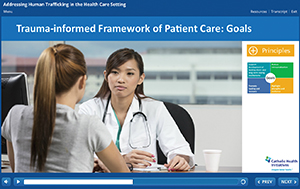By NANCY FRAZIER O'BRIEN
As part of its broader anti-violence initiative, Catholic Health Initiatives is offering a 25-minute web-based clinical educational module on human trafficking to anyone in the Catholic health ministry and beyond.
Aimed at health care providers in a variety of situations, the course — titled "Addressing Human Trafficking in the Health Care Setting" — was developed in conjunction with the Massachusetts General Hospital Human Trafficking Initiative.

Scanlon
"CHI has had a long-standing commitment to building a culture of nonviolence," M. Colleen Scanlon, CHI senior vice president and chief advocacy officer, said of "United Against Violence," a CHI campaign that also supports community-based prevention programs on such topics as bullying, domestic violence, shaken baby syndrome, teen dating violence and child abuse. "The focus on human trafficking grew out of that work."
Statistics on human trafficking are hard to come by but the International Labour Organization estimates that 20.9 million people are trafficked for forced labor worldwide each year. The organization's website says its estimate captures "virtually the full spectrum of human trafficking abuses."
The organization said in a 2014 report that global profits obtained from the use of forced labor were estimated at $150 billion per year, with about $99 billion coming from commercial sexual exploitation.
Human trafficking is not just a problem taking place outside U.S. borders. For example, the National Center for Missing and Exploited Children said it has received more than 1.9 million reports involving suspected child abuse imagery (child pornography) over the last 15 years.
Dr. Manoj Pawar, system vice president for clinical operations and a physician leader at the CHI national offices in Englewood, Colo., said the new educational module is designed to communicate two key points: "It's surprising the degree to which human trafficking takes place in the United States, and the next thing is how busy providers on the front lines can recognize that something might be going on."

Pawar
Although some of the signs might be the same, clinicians cannot respond to human trafficking victims in the same way that they would to, say, victims of domestic violence.
Human trafficking victims are "unique in that they often do not see themselves as victims," said Laura Krausa, an advocacy manager for CHI who helped create the educational module. "Traffickers are so very good at manipulating them mentally."
A sex trafficking worker "might be working in a mansion, have a car to drive and nice things, but also might be receiving horrible mental and physical abuse," Krausa added.
"That is not to suggest that probing questions will not be asked," Scanlon said. "But this kind of trauma needs to be treated in the context of a very safe, open patient-clinician relationship so this kind of information can be shared."
Studies have shown that 87 percent of those identified as human trafficking victims said they came into contact with a health care provider during the time they were trafficked.

Catholic Health Initiatives is sharing, without restrictions, its web-based class on human trafficking to teach health care providers and others to recognize and assist victims.
The educational module includes signs that a patient might be a trafficking victim and outlines steps that a clinician should take to get information and offer help. Those who take the course also can download to their mobile phones a brief guide that could help them refresh their knowledge if a case of possible human trafficking presents itself.
The course was deliberately limited to 25 minutes out of respect for the time crunch facing health care providers. In a health care setting, "there is not a lot of time in the day to take people out and train them," said Pawar. "We had to be very targeted about what we wanted to convey."
The cellphone-based guide also reflects the reality of the health care setting.
"We know that mobile device use is very heavy among our workforce," Pawar said. "For clinical work it's not like they are sitting down in front of a computer most of the day; they're not on websites."
"We wanted to leave something on their person that would allow them to access this crucial information at the touch of a button," said Krausa. "If they are in a situation where they begin to have suspicions, they can learn the red flags and how to go about the next part."
Scanlon said the educational module is being offered without restrictions to be posted on the websites of any Catholic health system or hospital and also is available to nonprofit organizations, government agencies, religious communities or any group that wants to share the information about human trafficking.
"We're thrilled when we hear people say they have posted it or shared it," she said.
The module for web browsers and mobile devises is published at catholichealthinitiatives.org/human-trafficking-and-the-role-of-the-health-provider.
Cutline and two namelines for story above
Catholic Health Initiatives is sharing, without restrictions, its web-based class on human trafficking to teach health care providers and others to recognize and assist victims.
Copyright © 2016 by the Catholic Health Association
of the United States
For reprint permission, contact Betty Crosby or call (314) 253-3477.